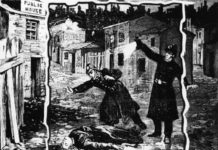King C Gillette was a creative entrepreneur and from the age of seventeen he dreamed of becoming an inventor and making his fortune. But there is quite a long way between dreaming of something and then actually inventing a brand new product.
He was born in 1865 and Gillette’s parents, both successful inventors themselves, then moved the family to Chicago where their business was devastated in 1871 during the Great Chicago Fire. For the next thirteen years Gillette struggled to make a living from his inventions and, in the end, managed to fail miserably.
Eventually he found work as a salesman although enjoyed little success and he finally returned to his parent’s house at the age of forty-years-old, unable to pay his bills and with little future to look forward to.
But Gillette refused to give up and went to work for William Painter, a local entrepreneur who had invented a disposable bottle cap which he had turned into a successful business.
In 1892 Painter had been awarded a U.S. Patent for his product, formed the Crown Cork and Seal Company and employed King Gillette to walk the streets of Baltimore and selling bottle tops from door to door.
One day, whilst out on his rounds, Painter joined Gillette and explained that the secret to a successful product was to invent something people would use once and then throw away. For Painter, the cork sealed bottle top had proved to be the perfect product. Gillette then decided he needed one of his own.
The following weeks turned into months and Gillette spent every waking moment trying to think of a product currently used by everybody that he could make disposable. One morning Gillette was shaving at his basin when he cut his face with his old, blunt cut-throat razor and as his blood dripped into the bowl his search for an invention was over.
He realised there and then that instead of every man sharpening an old straight bladed razor on a leather strap every morning, he would design thin, sharp blades that were so cheap to produce they could be thrown away after only a few shaves. That morning he left a note for his wife reading ‘I’ve got it, our fortune is made.’
Gillette then spent all of his spare time trying to find a way to manufacture blades out of thin steel that was strong enough not to bend or buckle, without success. Eventually Gillette, tired of his friends and associates joking with him about his failure in creating a new and modern safety razor, turned to Steven Porter, a machinist from Boston, who eventually thought up a way of sandwiching a thin, sharp blade between two stronger pieces of steel leaving only the sharp leading edge exposed, whilst he was eating a sandwich.
In the summer of 1899 Gillette became the first man to shave with a disposable bladed razor. But public opinion was firmly against him as, historically, a man’s razor was considered to be a once off purchase for life. Often razors were handed down from grandfather to grandson and the idea of throwing one away after only a few shaves seemed alien to the general public. Financing a marketing and advertising campaign was also out of the question as Gillette himself was broke and potential investors were sceptical.
However, William Emery Nickerson, an expert machine inventor, took a look at the razor and realised that if he made the blade removable, by adding a screw fix device, then only the thin, cheap blade needed to be thrown away and not the whole razor. Gillette immediately filed for a patent and formed the American Safety Razor Company in partnership with Nickerson and two investors.
The name of the company was soon changed to the Gillette Safety Razor Company and when early prototypes impressed investors Gillette was offered $125,000 in exchange for fifty-one percent of the company by a group of New York investors. The first advertisement for the Gillette Safety Razor appeared in the System Magazine in early 1903 offering one razor and twenty blades for $5, which was around half the average man’s weekly wage at the time.
Needless to say sales were slow and by the end of that year only fifty-one razors had been sold by mail order. Gillette remained a salesman for the Crown Cork and Seal Company and was quoted later as saying ‘The razor was looked upon as a joke by all of my friends. If I had been technically trained then I would have quit there and then.’
But the other investors remained positive and, despite nobody having drawn a salary from the new company, they decided to reduce the number of blades offered with the razor from twenty down to twelve. With that Gillette resigned and travelled to England but when he heard that his partners were planning to sell his patent to a European Company he raced back to Boston and convinced his allies to allow him to regain control of the company.
With new investment and renewed enthusiasm Gillette embarked on an advertising campaign that led to sales, in 1904, of 90,884 razors and 123,648 blades. By 1908 the company had established factories in Germany, France, Britain and Canada and had sales exceeding 450,000 units and 70million blades.
As the First World War broke out Gillette read that French and British troops needed to remain clean shaven in the trenches so that their gas masks would seal properly. When America entered the war Gillette offered the American Government razor sets for every soldier at cost price and received an order for 3.5million Gillette Safety Razor Kits.
This firmly established the reputation of the company and ensured a generation of men’s loyalty to its products. By then Gillette had become a multi-millionaire and all but retired from the company bearing his famous name.
But, unfortunately, he invested most of his money in property and on Wall Street and lost the bulk of it during the infamous Stock Market Crash of 1929 and subsequent Great Depression. Sadly, the man whose company would be sold in 2005 for $57 Billion died alone, a virtual bankrupt.
– Albert Jack
Albert Jack AUDIOBOOKS available for download here
More Awesome Inventions with Albert Jack






































